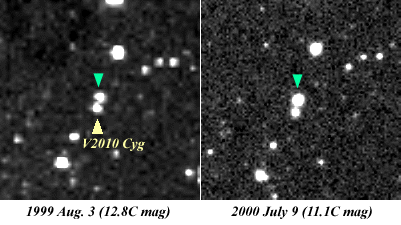Japanese version Home Page Updated on January 22, 2006
Mira Variable V2010 Cyg and Another Adjoining New Mira Variable MisV1340January 22, 2006Yoshida, S.; Ohkura, N.; Kadota, K.; Skiff, B.; Greaves, J. Seiichi Yoshida, MISAO Project, discovered a new Mira type variable MisV1340 from unfiltered CCD images taken by Nobuo Ohkura, Okayama, Japan; and Ken-ichi Kadota, Ageo, Saitama, Japan. 
This star is adjoining to a Mira type variable V2010 Cyg discovered by Lennart Dahlmark. The variability of this star was found already in 2000 in the course of the MISAO Project. But we found the position was extremely close to a Mira type variable V2010 Cyg = LD 162 with a range of 13.0 - <15.2 mag(V). In fact, this star is a northern component of double stars with similar brightness lying north-south direction with a separation of 20 arcsec. And the southern component is registered as V2010 Cyg = LD 162. Based on the measurements using the old system in 2000, no significant variation of the southern star was detected from the MISAO Project images. Therefore, we judged the identification of V2010 Cyg was wrong and the northern star, not the southern star, must be variable. We judged the following identification will be correct. Variable star of the MISAO Project = V2010 Cyg = LD 162 John Greaves and Brian Skiff researched the IBVS papers and commented on this identification. The coordinates published in the Dahlmark's discovery paper (IBVS 3855) are inaccurate. But in the chart, the southern star is marked as a variable. The southern star is USNO-A1.0 1200.14807721 (R.A. 20h09m44s.155, Decl. +31o58'49".18). In the revision paper by Skiff & Williams (IBVS 4450), this USNO-A1.0 coordinates are published as a accurate position of V2010 Cyg. However, the resolution in the original chart is not very good. In addition, no variability of the southern star is found between the DSS2 R images in 1991 and 1992, on the other hand, the variability of the northern star is evident. So it seemed correct that the mark in the original paper was a mistake and the northern star was a real variable. Therefore, we did not announce this star as one of our new variable stars in 2000. Instead, we reported the revision of V2010 Cyg's coordinates [vsnet-id 299]. However, in 2006, we concluded our identification above was wrong. We concluded both of the double stars are variable, the original position of V2010 Cyg was correct, and our star, the northern star, is a new variable star. The reasons for our conclusion are as follows. Based on the measurements using the latest system, the brightness of the southern star seems also slightly variable. So probably the variations of both of the double stars are detected. But because the resolution is nearly limit, we cannot affirm if the variation is real or not only based on the MISAO Project images. The double stars are very bright on the 2MASS images. The northern star is recorded in the infrared catalog MSX5C. The USNO-A2.0 color of the southern star is very reddish as B-R = 4.6 mag. Therefore both of the double stars are likely red variables. The NSVS detected the following Mira type variable at the position of the double stars.
The NSVS position is exactly the center between the double stars lying north-south direction. So the NSVS could not deblend the double stars and must have measured the blended brightness. The light curve is available as follows. http://skydot.lanl.gov/nsvs/star.php?num=8484079&mask=32004 http://skydot.lanl.gov/nsvs/star.php?num=8467488&mask=32004 Although the light curve shows a Mira type variation, it is asymmetric, that is, there is a large difference between the first and the last maximum brightness. This implies that two Mira type light curves are combined. Skiff re-examined the Dahlmark's chart and confirmed that it clearly marks the southern star. These facts derive the following two conclusions.
Therefore, we announce the northern star as another new Mira type variable MisV1340 adjoining to a Mira type variable V2010 Cyg. | ||||||||||||||
